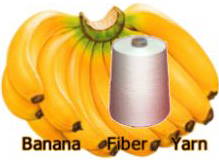

|
|

Banana fibers

Banana
Introduction
Bananas and plantains (Musa spp.) are important crops within the global fruit industry. They are cultivated in over 120 countries, over an area of 10 million hectares, with an annual production of 88 million metric
tons.
The banana plant, often erroneously referred to as a "tree", is a large herb, with succulent, very juicy stem (properly "pseudostem") which is a cylinder of leaf-petiole sheaths, reaching a height of 20 to 25 ft (6-7.5 m) and arising from a fleshy rhizome or corm. Suckers spring up around the main plant forming a clump or "stool'', the eldest sucker replacing the main plant when it fruits and dies, and this process of succession continues indefinitely. The fruit (technically a "berry") turns from deep-green to yellow or red, or, in some forms, green-and white-striped.

Many
Southeast Asian countries which plant banana have a large number of fleshy rhizome or banana bast
which still is wasted.
Properties
Banana fibers are:
Ø
a natural sorbent
Banana fibers in their natural state produce a highly sorbent material.
The key factor is the high porosity and natural capillary action of the
fiber, allowing it to absorb oil. Banana fiber is a super-sorbent, in
that less fiber product is needed to remediate any spillage. Banana
fibers can be used in sorbent socks, pillows and booms, or as loose
fiber to clean up land-based spills.
Ø
a base material for
bioremediation and recycling
Organic contamination is frequently treated through 'bioremediation', a
method that employs bacteria to 'eat' the contamination. In order for
these bacteria to survive within the contaminated environment, they must
be provided with a natural substrate material on which they will thrive.
Banana fiber provides this medium and can be used in the remediation
industry as a natural bioremediation agent.
Ø
a natural water purifier
Banana fibers have already been tested for use as a filtration agent in
the treatment of wastewater, which is often contaminated with oils and
other organic materials. The natural affinity of banana fiber to oils
and organics, and its tendency to repel water when oil loaded, makes it a good natural
alternative filtration agent for industrial and municipal waste
treatment.
Ø
a base material for the paper
and pulp industry
The use of banana pseudostem has been investigated for the production of
craft cellulose, to be whitened for use in the manufacture of special
paper used in the restoration of documents. The raw material used, at
nearly 94% humidity, is obtained from commercial banana plantations.
Paper made out of banana fiber is reported to be of high strength and is
used to make tea bags and currency notes.
Ø
a substrate in the mushroom
industry
A study conducted at the Instructional Farm, Vellayani, India, regarding
the suitability of banana pseudostem for mushroom cultivation, indicated
that banana pseudostem alone and in combination with paddy straw
produced comparatively higher mushroom yields than paddy straw alone.
Ø
a rawmaterial in handicrafts
and textiles
A variety of products have been made from banana fibers in the
Philippines. The banana fibers were reported to be elegant and highly
versatile. As they do not crumple easily, these fibers have been used in
the manufacture of dress materials. The fineness of texture depends on
the quality of the fiber used. The material has a beautiful sheen and is
used for making wedding gowns and barongs. Hand-extracted fibers have
been used to produce handbags, wall hangings, table mats and other fancy
articles.
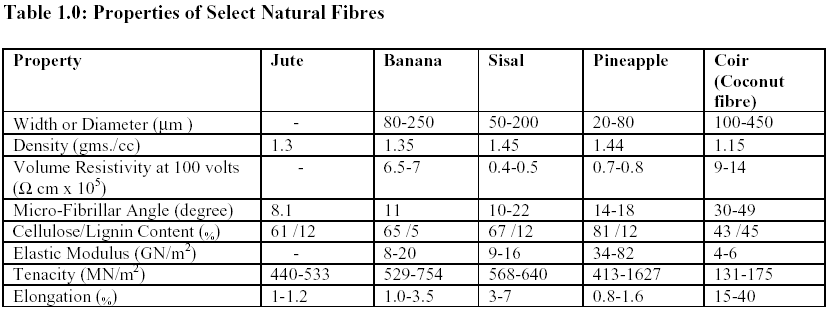
Banana fiber is classified as
a hard fiber, based on the fact that it includes strands of whole
vascular bundles, including xylem, phloem and true fibers. They have
more lignified and rougher surface fibers than cotton and kapok and soft
fibers such as flax, ramie, jute and hemp. The principal constituents of
banana fiber are cellulose (also called cellulose-1) intermingled
with hemi-cellulose (polysaccharides) and lignin.
Banana
as natural fiber
made from bast has been used in
Southeast Asian countries
but most of these fiber were too thick to be used in
textiles. Our banana fiber supplier partner is the first one in the world who is
able to produce finer textile fibers. The average fiber fineness is 4 dtex
and with this it is thinner than all other bast fibers.
The inherent drawback of
banana fiber is its poor quality and higher irregularity, owing to the
multi-cellular nature of the fibers. The individual cells are cemented
with lignin and hemi-cellulose and thus form a composite fiber. Banana
fiber is classified as medium quality fiber and performs very well in
combination with other fibers for making fine articles like handicrafts,
currency, etc.
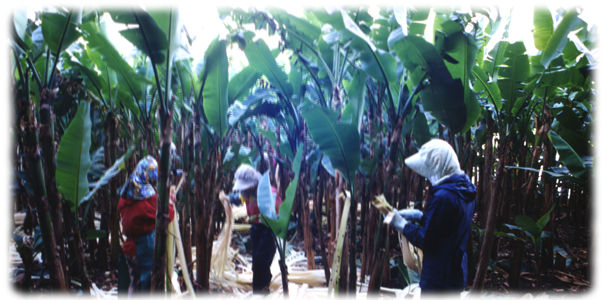
Banana fiber has
a good luster and banana
cloths have
a good
drape.
Banana fiber cloths are
very
noble, fashionable, environment-friendly and healthy. Because of higher
water absorption
banana fiber clothing is very cool.
Applications
-
Each and every part of banana
the plant is used for specific purposes. Apart from its
use as a dessert fruit and for culinary purposes, the
banana plant has multifaceted uses:
Ø
the leaf is commonly used as a
hygienic dining plate
Ø
the male flower is a favourite
vegetable
Ø
the inner core of the
pseudostem is a popular vegetable with many therapeutic
uses
Ø
the sap is used as an
indelible ink in industry and
Ø
the underground rhizome is
exploited as animal feed in a composite mixture with other
feedstuffs
The use of the spent banana
plant (after harvesting the bunch) for fiber extraction
has slowly gained recognition worldwide because of the
uses of banana fiber in
Ø
the paper and pulp industry
Ø
as a natural water purifier
Ø
for bioremediation and
recycling
Ø
for printing money
Ø
in the textile industry as a
base material for attractively patterned cloth:
- shirts
- bedding
- household textiles
- socks
Ø
in small-scale art and
handicraft industries and
Ø
in the production of a wide
range of goods, including
- rope cordage
- yarns
- abrasive backing paper
- tea bags and
- shoes.
Ø
Because banana fiber is
biodegradable, carrier bags made from it are an ideal
alternative to polythene bags, which are fast becoming an
environmental pollutant.
Our banana fiber yarn has two
specs: ring spun yarn and open-end yarn.
Technical parameters of banana
fiber:
- average fineness 2386 Nm
- average strength 3.93 cN /
dtex
- average length 50 ~ 60 mm (or
cut to 38mm).
Banana fibers can be used for
cotton spinning, OE-spinning, compact spinning and for
other short-spinning systems. They can be used on bast
fiber spinning systems (ramie, flax, hemp spinning), on
silk spinning, woollen spinning, semi-worsted and worsted
spinning systems.
Grades
- fibers
- tow/tops
- BCF yarns
- spun yarns
|
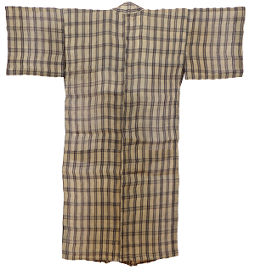
Bashofu = woven from
basho (banana) fibers, is very light
in weight and smooth to the touch. |
| Processability
We are in a position to
provide you
Ø
banana fibers for any spinning
system or
Ø
banana ring spun yarns from Ne
8/1 to Ne 40/1
in 100% or in blends with cotton, modal, Tencel or soy bean
protein fiber
Ø
banana fibers open-end spun
yarns from Ne 8/1 to Ne 30/1
in 100% or in blends with cotton, modal, Tencel or soy bean
protein fiber
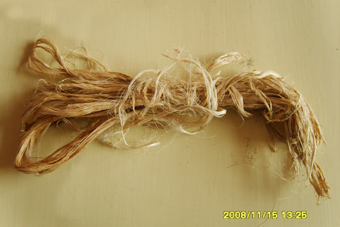
Degumming
the fibers by bio-enzyme - getting rid of pectin, lignin,
cellulose, hemicellulose and then carding fiber and spinning
the fiber on a bast spinning system.
Ecological value:
Natural resources are better used and involved peasant have more
income. Using more banana fibers means that consumption of
cotton or bast (ramie, flax, hemp) fibers will decrease and
that we have more land for planting foodstuffs.
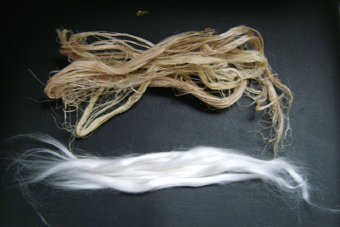
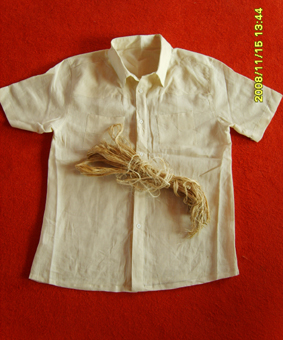
|
| Background
information
Botanical description
Plant: Plants are large, herbaceous
monocots, reaching 25 ft in some cultivars. The "trunk" or pseudostem
is not a true stem, but only the clustered, cylindrical aggregation of leaf
stalk bases. Leaves are among the largest of all plants, becoming up to 9 ft
long and 2 ft wide. There are 5-15 leaves on each plant. The perennial portion
of the plant is the corm which may weigh several kilograms. It produces suckers,
which are thinned to 2-3 per corm - one "parent" sucker for fruiting
and one "follower" to take the place of the parent after it fruits and
dies back. The vegetative apex spontaneously initiates a reproductive meristem
after 40 leaves have been produced, usually 9 months after initiation of a
sucker.
A banana plant bears fruit
10-12 months after planting; plantains take longer, 14-19 months, particularly
in areas with cool winters. The life of a banana plantation is 25 years or
longer, but individual "stools" are removed after production declines
in 4-5 yr, which helps to control diseases as well. Fields are cleared,
sometimes fumigated, then replanted with "bits" of new corms.
Flowers: The inflorescence is a spike
originating from the tip of the corm. Initially, it appears above the last
leaves in an upright position, and consists only of a large, purple, tapered
bud. As this bud opens, the slim, white, tubular, toothed flowers are revealed,
clustered in whorled double rows along the stalk, each cluster covered by a
thick, waxy, hood-like bract. The bract lifts from the first hands in 3-10 days.
Female flowers, with inferior ovaries, occupy the lower 5 to 15 rows on the
stalk, with neuter or hermaphrodite flowers in the center, and males at the top.
Male flowers and bracts are shed one day after opening, leaving the terminal
potion of the stalk naked except for the large, purple, fleshy bud at the tip
containing unopened male flowers (except Dwarf Cavendish - males persistent).
The flower stalk begins to droop down under its own weight shortly after
opening; the flowers are negatively geotropic, and turn upright during the first
10 weeks of growth.
Pollination: Bananas of the Cavendish
group are triploids, and therefore completely sterile; fruit is set
parthenocarpically. Traces of the undeveloped ovules are seen as brown specs in
the center of the fruit. Floral morphology suggests that wild bananas are bat
pollinated in their native range. Fruit: an epigynous berry, fruit are
borne in "hands" of up to 20 fruit, with 5-13 hands per spike. Fruit
appear as angled, slender, green "fingers" during growth, reaching
harvest maturity in 90-120 days after flower opening. The large, fleshy,
terminal bud on the stalk may be removed if fruit set is high, to allow more
complete filling of fruits (thinning) since this organ continues to grow
throughout fruit development.
'Giant Cavendish' bunch = 110 lbs @ 363
marketable fruits.
'Gros Michel' - produces 3-7 tons/acre/yr in
Central America.
'Maricongo' - high density plantings (5x5 ft)
produce 13 tons/acre/yr.
General Culture
A. Soils and climate.
Soils: Deep, well-drained alluvial soils
are best, but bananas can tolerate a wide variety of soil conditions. Bananas
require heavy fertilization for adequate yield - 200-300 lbs N/acre and up to
500-600 lbs K/acre are used.
Climate: The banana is adapted to hot,
wet, tropical lowlands. However, in South and East Africa, banana cultivation
may extend to 5000 ft above sea level. Mean temperature should be 80 F, and
about 4 inches rain/month are required, with dry seasons no longer than 3
months. Frost kills plants to the ground, although the corm usually survives.
B. Propagation. New banana stools are established
using corms or pieces of corms called "bits" or "eyes". In
the absence of bits, suckers from existing stools may be removed and planted. B. Propagation. New banana stools are established
using corms or pieces of corms called "bits" or "eyes". In
the absence of bits, suckers from existing stools may be removed and planted.
C. Rootstocks - none
D. Planting design, pruning, training
Design: Spacing between plants varies
proportionally to cultivar height at maturity, but generally 400-800
plants/acre are used. Common spacings range from 6x10 to 12x15 ft.
Pruning & training: Stools are
allowed to produce only 2-3 pseudostems at a time - one larger, fruiting stem,
and another smaller sucker that will produce fruit 6-8 months after the main
stem is harvested.
E. Backyard considerations. E. Backyard considerations.
Banana fruits are sensitive to chilling
temperatures ( 50 F), and cannot be produced outside the tropics commercially.
However, banana plants may be grown in the southeast as ornamentals, provided
they are protected from freezing. Fruiting is an extremely rare occurrence,
even in northern Florida, unless corms are overwintered properly and get a
head start on growth in spring. Dwarf types may be grown in tubs and moved
indoors during the winter, provided there is a sunny window. I fruited ‘Raja
Puri' bananas in Savannah in 1998! ..this is a fast maturing, dwarf type plant
with purple mottled leaves. Corms were set in February, killed back in a March
freeze, but grew to 6-8 ft and had bunches of fruit by November. Of course,
the Fall of 1998 was unusually warm.
Harvest,
post-harvest handling
A. Maturity. Fruits can be harvested when about
75% mature, as angles are becoming less prominent and fruits on upper hands are
light-green in color. At this stage, desiccated styles on tips of fruit can be
easily rubbed off. This occurs at 75-80 days after opening of the first hand.
Some managers manipulate the harvest date as per the direction of the buyer, and
harvest may be delayed up to 100-110 days after opening of the first hand.
B. Harvest method. Entire spikes are cut from
pseudostems by hand with sharp, curved knives. The cutter leaves a portion of
bare stalk as a handle for transporting to the packinghouse.
C. Post-harvest handling, packing. Bananas are
carried by hand to a packing shed, or in large plantations, hung on tramways and
pulled out of plantings by tractors; this expedites the process and limits
handling. Bananas should be kept out of light after harvest, since this hastens
ripening and softening. For local consumption, hands are often left on stalks
and sold to vendors who cut hands/fingers to customer's order. For export, hands
are cut into units of 4-16 fingers, graded for both length and width, and
carefully placed in poly-lined 40 lb boxes. Prior to packaging, fruits are
sometimes floated in water or dilute sodium hypochlorite solution to remove
latex which may cause black peel staining. Fruit are shipped by boat when green,
and ripened by exposure to ethylene gas (1000 ppm for 24 hr) at their
destination, in sealed "banana ripening rooms".
D. Storage. Fruit can be stored for a short time
after ripening at temperatures no lower than 55 F, since fruit are susceptible
to chilling injury.
Contribution to
diet, food uses
Other than fresh consumption, bananas &
plantains are used for:
1. Banana puree - baby food, cake, pie, ice
cream, doughnuts, etc.
2. Banana/plantain flour - from sun-dried fruits,
used for pastries; sometimes mixed with cassava flour.
3. Cooking - plantains are often fried in fat,
and eaten like french fries. Mofongo is fried green plantain mixed with pork
and seasoned.
4. Dried fruit - are sliced thin and sold as
chips, or larger and more moist sections as "banana figs".
5. Fermented bananas -made into beer and wine in
Africa.
6. The terminal male bud can be boiled and eaten
as a vegetable.
7. New shoots are collected and eaten as greens.
Dietary value, per 100 gram edible
portion:
Banana (Plantains a bit higher in calories,
but similar)
Water (%)
......................................... 74 (low for a fresh fruit)
Calories
............................................ 88
Protein (%)
........................................ 1.5
Fat (%)
............................................... 0.28
Carbohydrates (%)
............................. 22
Crude Fiber (%)
................................... 0.6
Vitamin A
......................................... 9
Thiamin, B1
...................................... 21
Riboflavin, B2
..................................... 3.8
Niacin
............................................... 4.4
Vitamic C
........................................ 47
Calcium
............................................ 1.1
Phosphorus
....................................... 3.5
Iron
................................................... 4.5
Sodium
.............................................. ---
Potassium
......................................... 9
* Percent of recommended daily
allowance set by FDA, assuming a 154 lb male adult, 2700 calories per day.
|
| Our
supplier partner
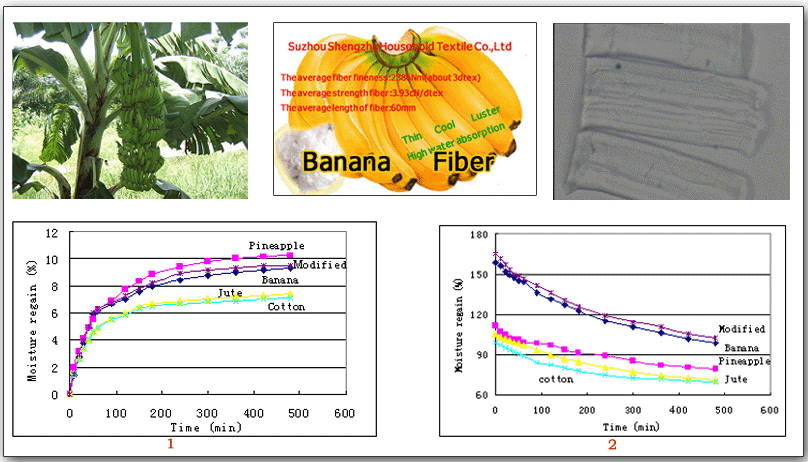
|
|



